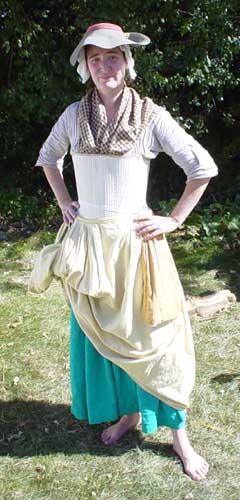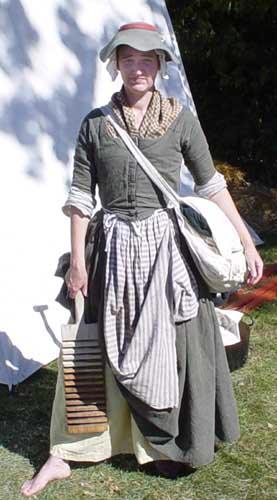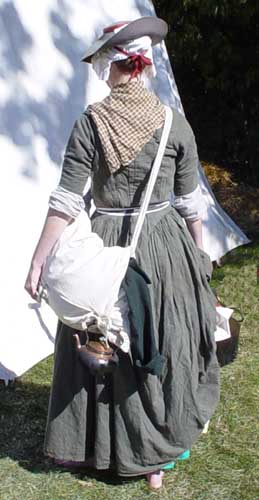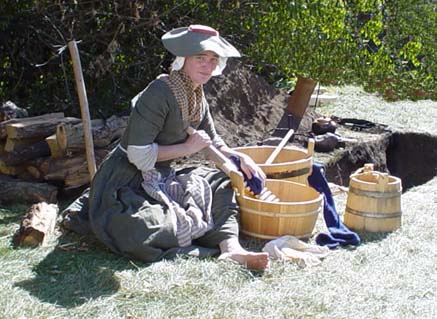In war zones throughout time, women have
always been a part of armies. Most often women are
the displaced, abused citizens that suffer from the
war. But with every army there have been women
traveling and living with the troops in some way.
These women have been wives that don’t want
to be left behind, can’t afford to stay behind, hired
to work for the army, had no place to stay, or were
simply adventurous women who used their husbands as a
way to see the world. Other women attached themselves
to the army as well. The most obvious of these are
prostitutes. There also were daughters, sutlers,
servants, and local women who attached themselves to
the army for love, survival, profit, or escape.
In the theatrical, living history world there will be a small
number of women attached to the regiment. All should
have a real world role and a historical role. What
follows is a general overview of women attached to the
military and the context that surrounds them for use
by women attached to this Regiment.
The life of a soldier was rough. When he
accepted the King’s (or Queen’s) shilling upon
enlistment, he usually was enlisted for life unless he
was an officer, therefore a gentleman, who had
purchased his commission and could then sell it to
leave the service. For the common man and soldier,
about the only ways out were forced retirement, death,
or a dishonorable discharge. Death was the easiest
and possibly the most common way. Infirmity due to
age or injury led to retirement but there was no
pension and by that time the soldier was usually
unable to work. If he had no family begging, crime or
the poor house were the only options for survival.
Pay was poor with deductions for equipment
expenses, accommodations, and uniforms. He received a
daily ration of food that included a pound of meat, a
pound of bread or flour, often beans or rice, and an
allotment of spirits. A wife received a half ration,
her child a quarter ration. At home the soldier was
lodged in an area tavern, its outbuildings, local
homes, or occasionally a regimental barracks. On
campaign lodging ranged from locals’ homes to forts or the open
sky.
Soldiers of all ranks were discouraged from
marrying because a wife and family were a distraction,
a financial and an emotional drain to the soldier.
There were many regulations denouncing the institution
of marriage. If a soldier wished to wed, he was to
get his commanding officer’s permission. The various
regiments had quotas of acceptable marriages, which
varied among them and depended on each year’s
regulations, commanding officers, and the War Office.
A soldier could wed if the CO found the bride to be of
good character and industrious – in other words, not
likely to be a deadweight to the regiment, and able to
support herself. Many soldiers did wed without their
CO’s permission and the harshest punishment for the
couple was the wife’s lack of recognition by the
regiment. Punishment for an unauthorized marriage
could and occasionally did include whipping or all
promotion and advancement up the ranks stopped. A
recognized wedding allowed the wife the opportunity of
regimental rations and work. Unrecognized women did
not get rations and had little chance for work from
the regiment.
The women who followed the army came from all
walks of life. Officers usually married ladies from
home of their social status. These women did travel
with their husbands but it is my impression that they
had less need to than the soldiers’ wives did.
Enlisted men married local girls, servants, and
prostitutes. Men from all ranks had mistresses. The
mistresses also came from similar social strata as the
men they were attached to.
As women married their soldiers their lives
became more precarious in many ways. A recognized
wife lived with her spouse in whatever lodgings
provided by the regiment when at home. Often it was a
bunk or part of the space he shared with the other
men, or maybe a hut he built outside the garrison in
his spare time. On the campaign housing was scarcer.
In towns, the regiment was housed first then the women
and other camp followers. Maybe she got to stay with
her husband. On the march the wife might share the
tent with her husband and his tent mates or if
stationed near a fort or, if in one location for a
while, a crude hut. If on the move, the open skies
often were all she had. As a recognized wife, more
permanent accommodations were a privilege as part of
the regiment – if there were enough. An unrecognized
wife would have to find her own lodgings or depend on
her husband to help find a place whether at home or on
campaign. If there were children with the wife,
recognized or not, everything was that more
complicated. Common-law wives, prostitutes, and
mistresses were in the same situation as the
unrecognized wives.
Women who attached themselves to a regiment
fell into several groups besides the ladies of the
officers. There are the local girls of good standing
– upper-class servants, daughters of merchants,
farmers’ daughters. Next were locals of less
impeccable standing – poor women, lower-class
servants, shop employees. The last group was the
prostitutes hoping for profit or security. Although
some prostitutes wed, with or without regimental
permission, most did not. The rest of the women were
wives. Both recognized and unrecognized legal wives
were married by clergy but many women became
common-law wives. Several reasons account for
non-legalized wives. The first reason was the lack of
clergy. On campaign there might not be a minister
seen for months. The second reason could be a
difference of religion whether between the couple and
the minister. The regiment preferred that the
common-law wife be legally bound to her soldier. This
made it easier, in theory, to keep track of and
control the women.
For more history on campfollwers in 1755 click
here
Back to top
General Costume Information

Shift - Linen or cotton in white or natural colors
with
elbow- and usually calf-length.
Stays - a/k/a corset The cut of the stays is to round
the figure toward the front and with a smaller expanse
across the back, with a lower, squarer neckline and
laced up the back and/or front. Cut your bodice to fit the stays.
Petticoats - These are simple tubes of linen, wool, and
some cotton pleated onto a narrow waist band or
drawstring. There are pocket slits on both sides and
the waist usually ties on each side or apron-style in
front & back. Most women wore at least 2 p’coats and
more for warmth if needed
Jackets - There are a variety of jacket styles. The
most common for the lower sorts were the bedgown and
the short gown both loose t-shaped coats that pinned
or tied in front. The saccque back was fitted in the
front & had loose pleats hanging from the shoulders.
There are also a variety of fitted jackets with and
without stomachers like the caraco..
Gown - There are several forms of gowns. There is the
single piece gown with several styles called open
robe, round gown, robe anglais or francais, and the
wrap gown among others. Another option is the
separate bodice and petticoat like the riding habit (men’s styled).
Caps - A must! Nearly every woman wore some sort of cap
on the hair at all times. Styles include the circular
flat cap, pinner, and round ear cap (curved around the
face to the ears w/ or w/o lappets). Most caps were
white and made of linen.
Hats - Hats were worn over caps when outdoors. Popular
styles were straw or felt hats with shallow crowns
(skimmers). Brims were either small or large and
floppy tied with ribbons. Encouraged to prevent sunburn!
Shoes - Shoes tended to have massive heels, pointed toes
and high, square tongues. Mules, called slippers,
were also common especially for those above lower class.
Accessories - Most women wore a large, square neck
handkerchief folded into a triangle over the
décolletage. It was tucked into the apron, stomacher,
pinned at the breastbone, or wrapped across the bosom
and tied in the small of the back (late in the 18th century).
Pockets were separate bags attached to a tape that
tied under the top petticoat and reached by a slit in
the seams. More common than pouches or purses.
Hoops - Upper class women wore pannier hoops of various
sizes. Middle class and lower class women wore
smaller hoops or hip rolls to simulate the wide
silhouette. Rural and poor women most probably did
not use hoops or rolls but depended on their
petticoats to provide the desired extra hip size.
Fabrics - The most common textiles are linen,
wool,
cotton & silk and various combinations of those. The
lower sorts wore mostly linen & wool. Colors were
those achieved through plant dyes with light clear
shades being the most popular. Stripes, small checks,
and floral patterns were popular though lower sorts
probably had mostly solid colored fabrics.
Basic Woman’s Costume Guidelines


The basic outfit for a woman in camp will include the
following items:
Shift (elbow-length sleeves with loosely gathered
cuffs or banded cuffs)
Stays
Under petticoat (1 or more)
Over petticoat
Bedgown/short gown/fitted jacket *
* or a one piece gown
Cap
Hat (straw or felt)
Stockings
Shoes
Apron
Women in a military camp would have been poorer and
of lower station than many civilians. Clothes should
reflect this in the choice of fabrics. Cotton was
still fairly expensive but wool and linens were very
affordable. Tapestries and silks also would be
expensive. If the women were able to loot, they might
have some pieces of good fabric but it would look
re-made and well worn. Plaids, stripes, and some
checks are typical patterns of fabrics. The stays
would have been worn although they could have less
boning than a society woman’s would.
Hair: Women wear hats or caps almost all the time.
Among the few exceptions are loose women and they
often wore hats for comfort, convenience or style. A
cap is worn for several reasons. It is a sign of
modesty and propriety. It keeps the hair out of the
smoke, fire and food. It also covers modern
hairstyles and hair tools such as barrettes. Covering
up a modern hairstyle does an incredible amount toward
convincing the audience of who you are portraying.
Long hair was “in” and bangs were rare even on
children. Poor women would have worn simpler
hairstyles like buns and braids whereas society women
wore elaborate powdered creations. Adult women would
have worn their hair dressed – pinned up somehow, not
hanging loose down their backs.
These are guidelines are based on an English persona
but the components are universal. There will be
ethnic differences in the shapes of the bodices, caps,
and the length of petticoats, colors, and types of
fabrics. As you develop your persona, research what
ethnic, as well as economic, differences would affect
your clothes.
Things to avoid:
Please avoid the following fashion faux pas:
• French or English Bodices as seen in catalogs.
There is no documentation for these although the
English bodice –could- be worn as jumps under a
regular bodice such as a short gown or bedgown for an
extra layer of warmth if you already own one and feel
you must use it. If you have any other options,
please don’t use either bodice style.
• Quilting calico prints. Most floral patterns
are
too small or 19th c. and the weight of the fabric is
usually too light.
• Floral and Toile patterned fabric. Until you’ve
really studied floral patterns of the period, it is
best to avoid them because many modern ones are too
big, too naturalistic or laid out wrong. Toile
patterns were not used in clothing. They were
upholstery & interior decorating fabrics.
• Mob-cap (”shower cap with lace”) style caps. There
are period caps called mobcaps but the construction is
different. There are many patterns available to
choose a better style from.
A note about plaids/tartans: Much recent research
generally finds that the association of a tartan-style
plaid with a certain clan was mostly a romantic
Victorian invention. Although plaids or tartans are
associated with a geographical area due to the dyes
available to the area and local weaving traditions,
they were rarely tied to a specific family or clan
until after our period.
References:
“Historical Costumes of England.” Nancy Bradfield
“A Picture History of English Costume.” C. Willet &
Phillis Cunnington
“Patterns of Fashion 1, circa 1660-1860.” Janet
Arnold
“Tidings From the 18th Century.” Beth Gilgun
“Whatever Shall I Wear?” Mara Riley
18cWoman List ~ a Yahoo Groups listserve
Women Following the Army
Blumenthal, Walter; Women Camp Followers of the
American Revolution
Mayer, Holly A., Belonging to the Army: Camp Followers
and Community during the American Revolution
Williams, Col. Noel T. St. John, Judy O’Grady and the
Colonel’s Lady. Pp. vi-79. Brassey’s Defence
Publishers, London, 1988.
Hagist, Don N., The Women of the British Army; A
General Overview. Autumn 1993.
Back to top
Resources
Below is a starter list of resources that are
recommended by other re-enactors.
Patterns:
JP Ryan Mantua Maker
Mill Farms Rocking Horse Farm
Kannik’s Korner Fig Leaf Patterns
Sutlers:
Burnley & Trowbridge, Five Rivers
Wooded Hamlet, Jas. Townsend
Bradley Company of the Fox, Lacis
Smoke & Fire, G. Gedney Godwin
Costume Reference Books:
Rural Pennsylvania Clothing – Gehret (RevWar)
Eighteenth Century Clothing at Williamsburg –
Baumgarten
Fitting & Proper – Burston
Costume in Detail – Bradfield
Revolution in Fashion –
Art of Dress – Ashelford
Costume Close Up –
Corsets & Crinolines – Waugh
Any art books on: William Hogarth
Thomas or Paul Sandby
Textiles for Colonial Clothing, a Workbook of Swatches
and information – Queen
Whatever Shall I Wear - Riley
General Reference Books:
Tidings from the 18th Century – Gilgun, Beth
Daily Life in 18th Century England – Olsen, Kirstin
Crucible of War – Anderson, Fred
Back to top
Back


![]() Ryan Gale Designs: rrgale@msn.com
Ryan Gale Designs: rrgale@msn.com